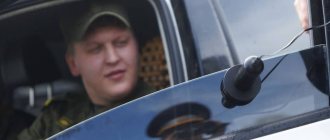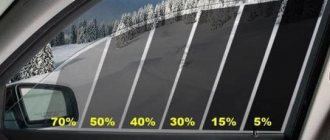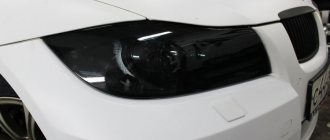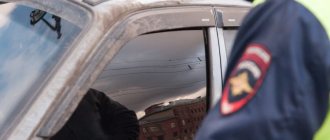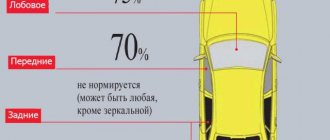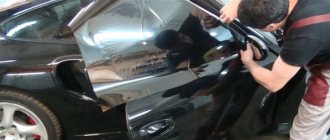- January 9, 2020
- Automobile law
- Inessa Zhebriakova
Every day, inspectors in cities stop vehicles and hold their drivers accountable for improperly tinted front windows. But do traffic police officers have the right to act in this way outside a stationary post?
What should be the rules for measuring tint? How should motorists behave and what should they pay attention to so that their rights are not violated? We will talk about this and much more in the article.
Law allowing tint inspection
The Code of Administrative Offenses of the Russian Federation has an article numbered 12.5. Part 3.1 presents the responsibility for installing color film on the windshield, as well as front side windows, which reduce light transmittance. If the car is equipped with glass that differs from the standard according to technical regulations, this fact will constitute an offense. You cannot drive such a vehicle.
Clause 4.3 of technical regulation 018/2011 specifies the minimum level of light transmission of the side front and windshields - 70%. The law prohibits dark tinting in the form of a film, removable tinting, or “curtains”.
Now all glass is checked in accordance with GOST 32565-2013 “Glass, safe for land transport. Technical conditions".
Is it possible to tint a car in winter in 2021?
Before buying a film, you need to find out whether it is possible to tint a car in winter in 2021, what needs to be done for this and what the requirements are. Often, car owners do not know whether it is possible to apply tint in winter, and what rules must be followed.
A traffic police inspector can stop the car at a traffic police post to check the windows for light transmittance.
If it does not meet the standards, a fine will be assessed. The stumbling block quite often becomes the question of whether it is possible to measure tint in winter. According to GOST standards, certain conditions must be met when conducting an inspection.
So, the glass is prepared - removing dirt and drying the surface, and it is also necessary to make sure that the weather matches the test - there are acceptable temperature and air pressure indicators. The driver may refuse the inspection if the inspector does not present his ID and documents for the device.
The two most common types of tinting are athermal and mirror.
What devices are allowed for measuring tint?
The device used to check the degree of light transmission is called a taumeter. Now the traffic police uses taumeters marked:
- "Blik-N";
- "Blik+";
- "Tonic";
- "Light".
The error of these devices should not exceed 2 percent. The taumeter is selected depending on the thickness of the glass being tested. All glass up to 7.5 mm thick can be measured with any device, and for glass with greater thickness, “Blik+” is provided.
Measuring tinting according to GOST
Changes have been made to the legislation regarding checking the degree of tinting of a car and measures of driver liability in case of violation of standards for light transmittance of glass.
Tint measurements must be carried out strictly according to the regulations provided by law.
Checking the tint can only be carried out at stationary traffic police posts. During the verification procedure, controversial issues may arise, which will be discussed in this article.
The technical regulations will determine new standards for the light transmission of car windows. Current regulations define the light transmittance of the front sphere of car windows to be 70% or more.
According to the standards in force before the amendments were made, the front side windows were allowed to be tinted with a darkening of up to 30%, and for the windshield this figure was 25%.
What are the requirements for a taumeter?
To measure tint according to GOST, you need to check the taumeter on time. Certification is carried out by the commission on measuring devices. There are some rules that determine the state of the taumeter:
- The certification commission checks the taumeter once every 12 months.
- The person responsible for the inspection puts an individual seal on it and issues a certificate.
- If there are no identification marks on the taumeter, the readings from the device can be considered unreliable. Such results cannot be included in regulations and a fine cannot be issued for them.
- The supply voltage range should be from 11.4 to 12.6 V.
- The certificate can be kept in the traffic police department, and a plate containing the verification date must be attached to the device.
How to measure tinting according to GOST in 2021
Measuring tinting according to GOST is carried out in accordance with numerous rules.
Not everyone knows that their violation will lead to the fact that, with appropriate treatment from the car owner, the measurement of glass light transmittance, which gave an unacceptable result, may be recognized as having no evidentiary value.
Car tinting is a procedure for determining the light transmittance of its tinted windows.
This process is carried out using special taumeter devices. Currently, common taumeter options are Blik (the most common device, including Blik+, Blik-N), Light, Tonic, Raster. This device must be used in accordance with the regulations.
The measurement is made at three points, the average calculated on the basis of the three figures obtained will be the desired value of light transmission. When taking measurements, it is necessary to check the accuracy of the device itself, as well as determine the accuracy of the readings of the instruments themselves that check the taumeter (measuring temperature, humidity and pressure).
Who has the right to measure the light transmittance of glass?
Road Technical Supervision, as well as any other traffic police officer who has a rank, can check the technical condition of a car. Other services do not have the right to check the level of light transmittance of car windows.
The special rank is regulated by the Law “On Police”. This can be absolutely any traffic police officer from junior to senior management.
The rules for measuring tinting imply checking the level of light transmittance of glass at a police control post, as well as at stationary traffic police posts.
Who has the right to measure
Contrary to popular belief, any traffic police officer can take measurements. He does not require any additional clearances. It is also allowed to take measurements anywhere.
Rumors that measurements are taken only at stationary points have a basis in reality. The fact is that until recently Order No. 1240 was in force, which indicated that tinting checks could only be carried out at checkpoints or certified technical inspection points. Now this norm has been canceled.
It turns out that the check can be carried out by any traffic police officer, and anywhere on the road. He should not have any additional permits or documents.
Weather
Tinting is checked only under certain weather conditions:
- Atmospheric pressure should be within 760 mmHg (+/-30).
- Permissible air humidity is 60% (+/-15).
- The air temperature should vary between 20-25 degrees. Some taumeters can also be used at higher temperatures.
- In winter, air temperatures should not be lower than -10 degrees.
Tinting is not measured in rain or fog. Many people are interested in the question of whether it is possible to check the tint at night. There are no restrictions regarding the time frame - measurements can be taken even late at night.
Conditions under which measurement results will be reliable
In order for the measurement results to be reliable and true, the procedure should be carried out under certain weather conditions:
- ambient temperature 20 degrees Celsius with an error of 5 degrees;
- air humidity 60 percent with an error of 20 percent;
- pressure 86-106 kiloPascal.
The taumeter readings are not affected by the time of day. Measurements can be taken during the day or at night. In this case, the output parameter values will be identical. This is because the device identifies the percentage of light rays that penetrate the glass rather than being absorbed by it. The readings measured in rainy weather will not be relevant due to increased humidity and the presence of drops on the glass.
How to check glass for light transmittance
The rules for measuring tint provide the following algorithm of actions:
- The inspector measures the current air temperature and humidity, and atmospheric pressure.
- The glass must be wiped until clean and dry.
- You can measure if the device has an error of 2% or less.
- The inspector presents the driver with a certificate or shows a sign containing the date of inspection of the tuamere, a protocol, or a personal document according to which he has the right to carry out measurements.
When there is nothing to complain about
However, there are situations when everything plays into the hands of the traffic police officers. And the weather is excellent, and the device is new, certified with all the documents and seals, and the mains voltage is 12V, in general, you can’t tamper with it.
Then all that remains is to give permission to check the window tinting, and if the tinting indicators exceed the standard, then you will be asked to remove the tinting on the spot and draw up an administrative protocol.
If you have removed the tint, the car may be checked again and you will be released.
But if you refuse to remove the tint, then the license plates may be removed from your car and given one day for you to eliminate the violation. Naturally, an administrative protocol will be drawn up.
Numbers will only be returned if the tint is removed and a fine is paid.
However, it should be remembered that if the installation of tinting on your car was carried out at a specialized service station or car service, then such work there must be carried out fully in accordance with existing rules.
They are required to check your window tinting to ensure it is up to code before telling you that the work is complete.
Therefore, you should not forget about consumer protection and contact this company for compensation. As a rule, everything is resolved amicably, but not always.
Some car owners who have extra time and money turn to the courts. But you already have to be too principled a person.
Recently, such problems are becoming less and less common. Firms began to very carefully check the window tinting of their clients’ cars for compliance with standards, and the problem began to disappear by itself.
But still, if anyone has had problems with traffic police officers regarding issues of checking window tinting that are not covered in this article, please share them in the comments.
Tinting and the law - video.
Source
Operating instructions for taumeter
We will describe the instructions for the most popular device among police officers - “Blik-N”. If measurements are made in the field, it is attached to a strap that is worn around the neck.
To take measurements, you need to connect the device cord to the car's cigarette lighter, which has a 12V power supply. Next, the taumeter warms up for several minutes. If the device is moved from indoors to fresh air or vice versa, the inspector must make sure that the glass on the head of the device has not fogged up or frozen.
You also need to determine which frame is suitable for the glass depending on its thickness. Next, you need to set the device indicator to 100%. If the indicator is unstable, the values on the indicator will flash.
To adjust the apparatus, the receiving and transmitting heads are placed opposite each other on both sides of the glass being measured. It is important to ensure that there is no sudden impact on the glass, since both heads are attracted to each other via a magnet.
If the rules for checking tinting are followed, the indicator will display a number that determines the light transmittance of the glass.
At what sub-zero temperature are traffic police inspectors not allowed to measure tint?
1) The inspector will be able to draw up a protocol on tinting and remove the license plates only after measuring the light transmittance of the glass.
If the crew doesn’t have any equipment, you can safely wave the hand and drive on under the sad gaze of the inspector. 2) If you do have a device, check that there is a valid certificate and seal on the case.
In addition, the permissible power supply for the device is 12 volts (plus or minus 0.6 volts), we also check the power supply to which the inspector connects the device.
Do not connect it to your cigarette lighter. Any discrepancy (for example, a Chinese battery without identification marks) is a good-bye, traffic cop. 3) Find out the thickness of your glass. Most devices are not certified for measuring the tint of glass thicker than 7.5 mm; thick glass can only be measured with the BLIK+ devices (a simple BLIK does not work) and TONIC.
Tell the inspector that the thickness of your glass is 9mm, and he has no right to take measurements using Glare.
Do I need to go to a stationary traffic police post to take measurements?
If a police officer stopped a driver at a traffic police post and asked him to undergo a check for the light transmittance of car windows, the motorist has the right to refuse to do this, even if the windows of his vehicle are completely tinted.
In this case, the inspector may suggest driving to a stationary post in order to comply with all the rules for measuring tint. Even in this case, the driver may refuse. To force a motorist to go to the inspection point, a police officer must carry out administrative detention. Is this legal?
No, it's not legal. The Code of Contraventions states that it is possible to restrict the freedom of a motorist or any other person only in situations where it is necessary to promptly consider the case of an offense. In this case, detention cannot be used to detect an offense. You can detain a car only if a violation has already been detected, but not before it.
In what weather conditions can tint be measured?
Clause 7.3 of the List of Malfunctions and Conditions from the Traffic Regulations prohibits the operation of vehicles with the installation of additional items or coating that limit visibility from the driver’s seat. This applies to both tinting in the form of a film and various removable structures - removable tinting, “curtains” and other coverings that limit the driver’s view.
If the light transmittance of window tinting is below the norm, the car owner becomes a violator of Article No. 12.5 of the Code of Administrative Offenses of Russia. The fine is 500 rubles.
The Administrative Regulations currently in force do not establish such restrictions. The inspector can conduct an inspection when stopping a vehicle on any section of the road.
Until February 1 of this year, it was allowed to have only tinting on the windshield whose light transmittance was at least 75%. Employees of the State Traffic Inspectorate check the light transmission of tinting.
Any traffic police officer has the right to measure the car's tint. These powers are enshrined in the Code of Administrative Offenses in the Russian Federation. The controversial issue was the location of the inspections. Order of the Ministry of Internal Affairs No. 1240, which was in force previously, required monitoring of the technical condition of vehicles at stationary traffic police posts or at inspection stations.
Current legislation requires that the minimum level of light transmission of the windshield and side windows be at least 70%. There are no restrictions on the coverage of rear windows, with the exception of the prohibition on the use of mirror tinting.
A wide range of offers and availability of car window tinting services and a relatively small administrative fine (500 rubles) make it possible for drivers to remove it in front of an inspector, and then immediately go to a car service center and stick a new one on. In addition, so-called removable tinting options are gaining popularity, which can be removed and applied without damage.
If the tinting is not removed within the specified period and the fine is not paid, then upon re-inspection the driver will face a fine of 1,000 rubles or arrest for up to 15 days for failure to comply with the legal request of a police officer. It is important to understand that only a court can order an arrest or a second fine.
A change in light transmittance beyond the permissible limit limits visibility, especially at dusk and at night, resulting in an increase in the number of accidents.
Turning to the same GOST 32565-2013, namely clause 7.8.7, we learn that in case of disagreement on the method for measuring light transmittance, the method described in clause 7.8 of GOST is used.
GOST discloses only the general verification methodology, violation of which, as a rule, leads to either a complete absence of instrument readings or is practically unprovable for the driver. Sports media reported that fighter Khamzat Chimaev left the UFC, fans of the athlete immediately began to remember the best moments in the fights with his participation. Khamzat himself commented on the information about his departure.
If the rules for checking tinting are followed, the indicator will display a number that determines the light transmittance of the glass.
No, it's not legal. The Code of Contraventions states that it is possible to restrict the freedom of a motorist or any other person only in situations where it is necessary to promptly consider the case of an offense. In this case, detention cannot be used to detect an offense. You can detain a car only if a violation has already been detected, but not before it.
Can a traffic police officer's decision be illegal?
Traffic police often take advantage of the fact that motorists have little knowledge of laws and regulations. As a result, few people will challenge a fine of 500 rubles. Here is a list of illegal actions on the part of the inspector:
- You cannot measure the light transmittance of glass “by eye,” even if the inspector “can already see everything.” Even if the glass is heavily tinted, the inspector must check it with a taumeter.
- If the traffic police officer does not have a measuring device, he can simply write out a protocol in which it will be written that there are objects installed on the vehicle that limit visibility. There will be no fine in this case.
- The inspector cannot force the driver to remove the tint without taking measurements.
- If a traffic police officer claims that a car has removable tinted windows, that is, the design of the vehicle has been subject to illegal changes, he must confirm his words through measurements with a device.
Table of contents
- Who has the right to measure
- How is light transmittance measured?
- Norms
- Regulatory acts
- Measurement Rules
- Inspection violations
- Possibilities for canceling the fine
- conclusions
If you decide to darken your car windows, you should know the rules for measuring tint. This will help avoid a fine. In general, there are quite a lot of myths and inaccurate data on this issue. Let's figure out in order who has rights to what, as well as how to avoid problems when meeting with a traffic police inspector.

